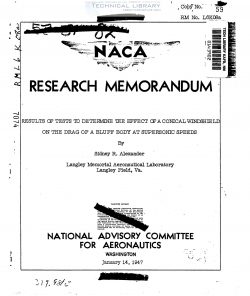naca-rm-l6k08a
- Version
- 243 Downloads
- 470.93 KB File Size
- 1 File Count
- March 14, 2017 Create Date
- March 14, 2017 Last Updated
National Advisory Committe for Aeronautics, Research Memorandum - Results of Tests to Determine the Effect of a Conical Windshield on the Drag of a Bluff Body at Supersonic Speeds

As part of an investigation to determine the characteristics
of free bodies at supersonic speeds, preliminary tests have been
made by the Langley Pilotless Aircraft Research Division in
wallops Island, Va. to evaluate the effect of a conical windshield
on the drag of a bluff body. The use of a windshield of the type
tested was suggested as a possible simple means of increasing the
effective fineness zatio of a fuselage with little increase in
structural weight. It was thought that the conical point would
eliminate the intense normal shock ordinarily formed at the nose
of a blunt body and would, through the action of its wake, effec-
tively increase the fineness ratio of such a body In addition,
if the drag of a blunt nose could be minimized in this manner, the
problem of forward vision of either seeker units or pilots in
supersonic aircraft would be simplified.
The rocket—propelled test bodies were about 5 feet long and
5 inches in diameter and consisted of identical wooden 3fterbodies
and fins to which the various nose shapes‘were attached. The nose
shapes tested consisted of a. sharp nose oi' approgchnstely circular
arc profile, a. blunt nose of hemi spherical shape, and the blunt
nose wi :11 a. smell conical windshield having the same nose angle
and supported at the same position as the original sharp nose.
The fuselages were'msde hollow to accommodate the propulsion unit,
.3. stendurd 3.2=-inch Mk. 7 aircraft rocket:m3tor._dev'eloping a.
constant thrust of about 2200 pounds for 0'. 87 second at an mbient
preignition temperature of 69°_ F_.___The four stabilizing fins were
equilly spiced around the rear of each fuselage and consisted
of flat surfaces with rounded lending edges swept beck 115° and
trailing edges cut off perpendiculnr to the surface; The general
bodv arrangement and the ncse shapes tcstéd are shown in figure 1.
Photographs of the bodies are shown in figure 2, end a. close—up ' ' 4
of the aluminum conical wind shield and bomb. is Shown in figure
Two models of. each body configuration were tested. _-'_
The experimental anti were obtcinod by launching the body
at an angle of 75° to tlve horizontal and Eotcmming' its velocity
along the flight path by the use of CW Doppler red-3.1" (Ali/T935).
Photographs of the l; uncher and r3d.a_r are _shown in figures M3.)
and Nb), respottively. A typical curve__ of velocity 23g: inst _
flight time obtained from :3. radar record is given in figuio 5. " TT
Drag date. were dint-lined by diff erentinting the part if the curve
corresponding to the time the bodies woregcoastmg (after 'he
propellant had. been expended) and converting the values of
deceleration thus obtained into corresponding values of drag
coefficient. The tests covered an approximite rlngc of 143.011
number from 1.0 to 1.1+. The corresponding Reynolds nmnbers,
based on the body diameter, ranged between 3 and il- million.
| File | Action |
|---|---|
| naca-rm-l6k08a Results of Tests to Determine the Effect of a Conical Windshield on the Drag of a Bluff Body at Supersonic Speeds.pdf | Download |

Comment On This Post